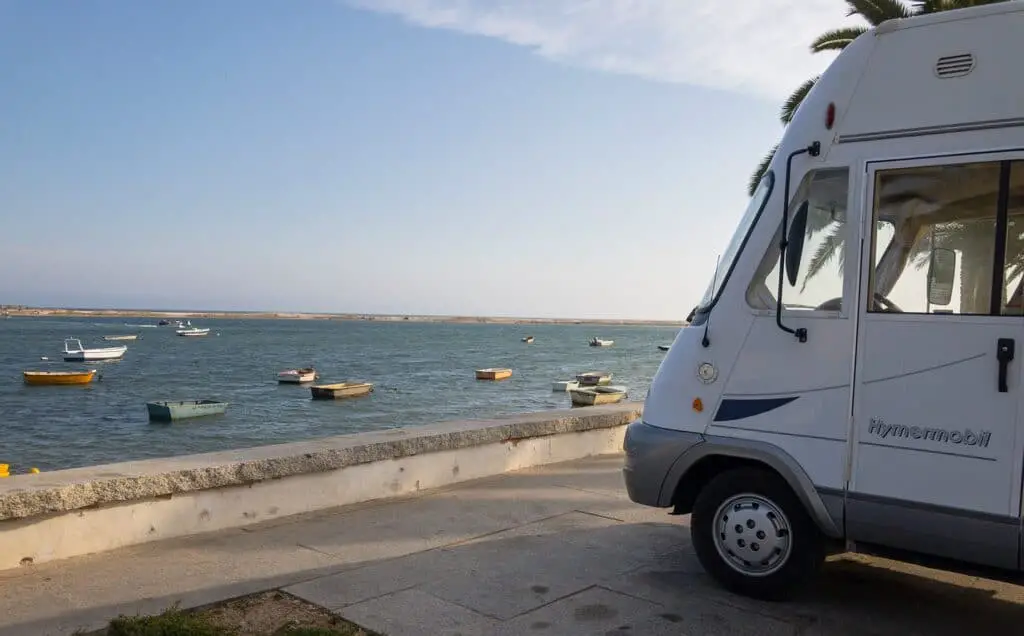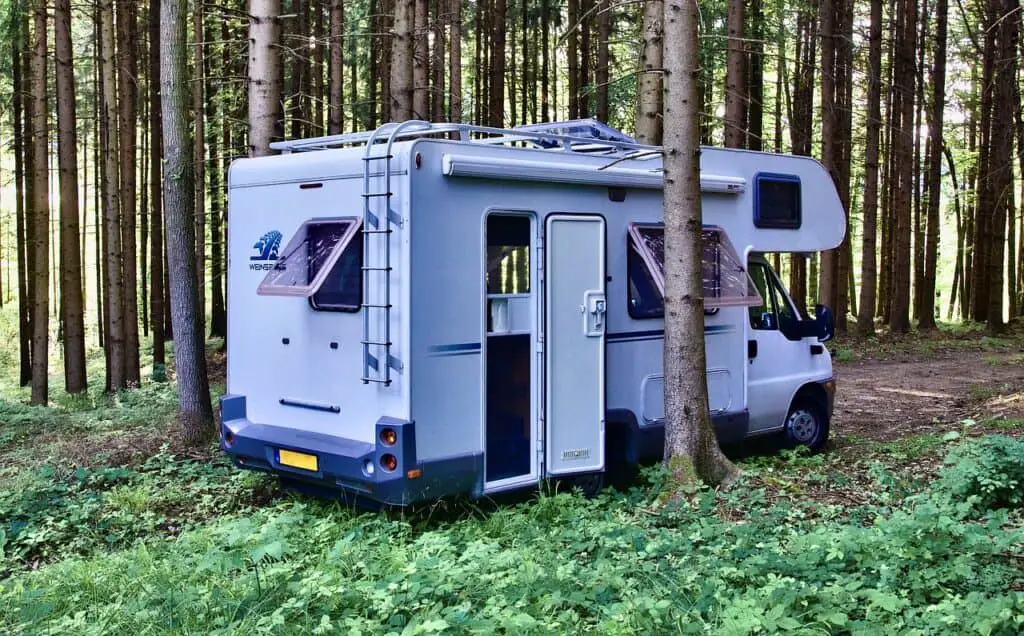We hope you like the products we recommend! Just so you know this post contains affiliate links and I will be compensated if you make a purchase after clicking our links.
Disclaimer
As an Amazon Associate, I earn from qualifying purchases. I get commissions from purchases made through links in this post.
More people than ever are choosing to holiday in the UK in a motorhome. With COVID-19 disrupting so many people’s foreign travel plans, the popularity of the motorhomes, campervans and RVs, is only going to grow.
But what happens if you have pets? And more specifically, can you take a cat in a motorhome in the UK?
We wanted to find out.
We’ve also got some tips and suggestions on how motorhome with your cat in comfort and safety. We’ll be suggesting a few products, too, that we think may be useful. They’re affiliate links so if you purchase something using one then we make a small commission at no cost to you 😊
Can you take a cat in a motorhome in the UK?
The short answer is yes.
You can take a cat in a motorhome in the UK. If you’re renting one, it is worth checking the pet-friendly policy before booking as some companies may have restrictions or additional guidelines for pets.
We did a really quick Google search and found a lot of motorhome rentals in the UK that do allow animals so don’t let taking a cat put you off booking.
Now you know that you can take a cat in a motorhome, there’s nothing stopping you from packing your furriest family member up and hitting the open road but before you go there are some things you might like to consider before setting off.

Motorhome Travel with a Cat in GB: Tips and Suggestions
- Check with the motorhome rental company and with any camping grounds to be sure that pets are welcome before booking.
- You should think about the cat’s personality before traveling, too. Independent cats that enjoy roaming outside probably won’t be happy at having their territory reduced so dramatically. You can, of course, take them out on a harness or a leash for fresh air and exercise but some cats won’t be suited to the campervan lifestyle.
- You know your cat better than anyone else so the decision on whether to take them has to be made with everyone’s best interests at heart. For some cats, it’s better to either leave them at home with daily visits from a sitter, family member or friend, or putting them into a cattery.
- If you decide to take your cat with you, then you’re going to have to cat-proof your motorhome before setting off.
- You’ll need to stop thinking like a person and start thinking like a cat. Cats are experts at finding spaces to crawl into or under. Getting on your hands and knees to see the world from their perspective should help give you an idea of any problem areas. You’re also looking for sharp edges or places they could get stuck.
- If you have an indoor cat, then negotiating a closed-door system to stop the cat escaping will be familiar. Other owners may find it tricky to remember to keep the cat inside with the doors and windows secured. You don’t want your cat escaping into unfamiliar territory.
- If you’d rather not act like a bouncer for your entire trip, you can buy indoor and outdoor cat enclosures that are like pop-up baby playpens but for cats. These are useful if you need to keep coming into and out of the van or if you’re expecting company.
- If you’re worried about your cat getting out and disappearing, then you can also buy a cat tracker that’s attached to the collar (opens to Amazon) You can then locate your cat through your phone.
- Make sure your cat is microchipped and that the details are up-to-date.
- Your pet should also be up-to-date with her vaccinations, too, especially if you’re letting them out.
- If they’re happy wearing a collar, then a disc with your mobile phone number on it can be useful.
- Training your cat to use a leash or harness can be a valuable thing to do before you go. Once secured it’s a great way to get the cat some fresh air and exercise. If you’re not a fan of walking a cat on a lead, then you can also buy pet pushchairs which are ideal for cats unable to walk very far because of injury, old age or illness. A harness like this one on Amazon may be useful

- To help ensure that your cat gets the most of its motorhome experience, it’s a good idea to start training them ahead of your trip.
- Cats can take some time to get used to new carriers, leads or harness, and it’ll be easier to do this at home rather than in the back of your campervan when you’re already away.
- The same goes for the motorhome, too. Introducing the cat ahead of time can make a big difference on when your start your trip. We’d recommend putting the cat inside with the door closed and letting them just wander around and explore. You might find it helpful to leave a few treats dotted around for them to find. Adding familiar smelling bedding or toys can also help them feel more secure inside the motorhome.
- You should try this a few times. If your cat is prone to anxiety, then using a cat calming spray may help.
- When the cat seems okay with being inside the RV you can then start the engine. Watch the cat for its reactions and be prepared to stop if it becomes too agitated.If it seems fine then take a short drive around the neighbourhood or further down the road. It’s helpful if there’s someone else there while your driving to continue positive encouragement and to supply treats.
If you’re going to be travelling in your motorhome long term, then it’s a good idea to do an overnighter with the cat in the van beforehand. Once your cat is used to the motorhome then you shouldn’t have any major dramas when it comes to setting off on your holiday or road trip.
- Of course, some cats will just jump in no problem. As with most things, it depends on your cat’s personality and how open they are to being in a vehicle. You’ll find lots of accounts on the internet of people who’ve travelled for years around different countries with their cats with no problems.
- If your cat is very unsure or nervous, then they might benefit from being kept inside their carrier more often. You can always cover it over when you’re traveling to minimise motion sickness.
- A cat carrier with familiar bedding and toys put in a quiet area of the motorhome is a safe space for her to retreat to. When you’re driving, it’s also a secure space for your cat to sleep in. We’d recommend that you keep your cat inside its carrier when you’re driving. Cats can distract the driver and have even been known to crawl under the pedals. In the event of an accident, it’s safer for everyone for a cat to be secured.
- If you’re concerned about the safety of your cat when driving, you can buy a SleepyPod which is a crash-tested carrier and bed.(Amazon link) It’s more expensive than a regular carrier but is worth considering if you’re going to be on the road a lot.
- But it’s not just a safety issue, it’s good for cats to have their own quiet space to hide in. This should help discourage them from trying to disappear under or in things inside the camper van or motorhome that they shouldn’t.
- Cats love to climb and sit up high but there may not be many high spaces in a motorhome so adding shelves can help or adding window perches or hammocks should help encourage their natural instincts to go high.
- You’ll need a spot for their litter tray, too. Often people place these in the toilet area of the motorhome. When you’re operating with limited space, it’s more difficult to keep the litter tray out of the way and apart from any food or water bowls. You can buy disposable litter trays (Amazon link) which may be more practical when you’re traveling.

- Don’t forget to include their toys and blankets. They’ll want creature comforts, too.
- Adding a cat scratcher (Amazon) may save some of your furniture especially if they cat isn’t able to have adequate access to the outdoors where it would naturally scratch at trees.
- Cats should have access to clean drinking water and if you’re driving with your cat then you might find anti-slip bowls useful to stop water sloshing (Amazon) over the floor.
- It’s useful having your pet’s medical history with you if you’re traveling long-term. This will help if you need to visit a vet whilst your away.
- If you’re visiting rural places, then it’s handy to have a small feline first aid kit with any medications.
- You shouldn’t leave your cat alone in a motorhome in very hot weather.
- Worried about leaving your cat alone when you’re off out and exploring? You can always set up a small security camera (Amazon) to keep an eye on them.
You can take a cat in a motorhome in the UK and we think it’s a great way of sharing your travels with your furry family members. Of course, not all cats are suited to life on the road and some will prefer being left at home with a cat sitter or staying safe and secure in a cattery.
You should take into consideration your own needs too, as traveling with a cat in a motorhome can be a challenge and may not be worth the effort for shorter trips.
There are certainly many benefits to jumping into a campervan and being on the road with a pet but we’d encourage anyone to think carefully being setting off.
But if you do decide to take your cat in a motorhome then we wish you very happy travels!